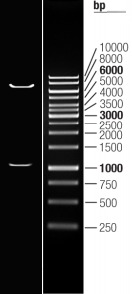SLAMF7 (NM_021181) Human Tagged Lenti ORF Clone
CAT#: RC220985L3
- LentiORF®
Lenti ORF clone of Human SLAM family member 7 (SLAMF7), Myc-DDK-tagged
"NM_021181" in other vectors (6)
Specifications
| Product Data | |
| Type | Human Tagged ORF Clone |
| Tag | Myc-DDK |
| Symbol | SLAMF7 |
| Synonyms | 19A; CD319; CRACC; CS1 |
| Vector | pLenti-C-Myc-DDK-P2A-Puro |
| E. coli Selection | Chloramphenicol (34 ug/mL) |
| Mammalian Cell Selection | Puromycin |
| Sequence Data |
The ORF insert of this clone is exactly the same as(RC220985).
|
| Restriction Sites | SgfI-MluI Cloning Scheme for this gene |
| ACCN | NM_021181 |
| ORF Size | 1005 bp |
| OTI Disclaimer | Due to the inherent nature of this plasmid, standard methods to replicate additional amounts of DNA in E. coli are highly likely to result in mutations and/or rearrangements. Therefore, OriGene does not guarantee the capability to replicate this plasmid DNA. Additional amounts of DNA can be purchased from OriGene with batch-specific, full-sequence verification at a reduced cost. Please contact our customer care team at custsupport@origene.com or by calling 301.340.3188 option 3 for pricing and delivery. The molecular sequence of this clone aligns with the gene accession number as a point of reference only. However, individual transcript sequences of the same gene can differ through naturally occurring variations (e.g. polymorphisms), each with its own valid existence. This clone is substantially in agreement with the reference, but a complete review of all prevailing variants is recommended prior to use. More info |
| OTI Annotation | This clone was engineered to express the complete ORF with an expression tag. Expression varies depending on the nature of the gene. |
| Product Components | The ORF clone is ion-exchange column purified and shipped in a 2D barcoded Matrix tube containing 10ug of transfection-ready, dried plasmid DNA (reconstitute with 100 ul of water). |
| Reconstitution | 1. Centrifuge at 5,000xg for 5min. 2. Carefully open the tube and add 100ul of sterile water to dissolve the DNA. 3. Close the tube and incubate for 10 minutes at room temperature. 4. Briefly vortex the tube and then do a quick spin (less than 5000xg) to concentrate the liquid at the bottom. 5. Store the suspended plasmid at -20°C. The DNA is stable for at least one year from date of shipping when stored at -20°C. |
| Reference Data | |
| RefSeq | NM_021181.3 |
| RefSeq Size | 2672 bp |
| RefSeq ORF | 1008 bp |
| Locus ID | 57823 |
| UniProt ID | Q9NQ25 |
| Cytogenetics | 1q23.3 |
| Protein Families | Druggable Genome, Transmembrane |
| MW | 37.2 kDa |
| Gene Summary | Self-ligand receptor of the signaling lymphocytic activation molecule (SLAM) family. SLAM receptors triggered by homo- or heterotypic cell-cell interactions are modulating the activation and differentiation of a wide variety of immune cells and thus are involved in the regulation and interconnection of both innate and adaptive immune response. Activities are controlled by presence or absence of small cytoplasmic adapter proteins, SH2D1A/SAP and/or SH2D1B/EAT-2. Isoform 1 mediates NK cell activation through a SH2D1A-independent extracellular signal-regulated ERK-mediated pathway (PubMed:11698418). Positively regulates NK cell functions by a mechanism dependent on phosphorylated SH2D1B. Downstream signaling implicates PLCG1, PLCG2 and PI3K (PubMed:16339536). In addition to heterotypic NK cells-target cells interactions also homotypic interactions between NK cells may contribute to activation. However, in the absence of SH2D1B, inhibits NK cell function. Acts also inhibitory in T-cells (By similarity). May play a role in lymphocyte adhesion (PubMed:11802771). In LPS-activated monocytes negatively regulates production of proinflammatory cytokines (PubMed:23695528).[UniProtKB/Swiss-Prot Function] |
Documents
| Product Manuals |
| FAQs |
| SDS |
Resources
Other Versions
| SKU | Description | Size | Price |
|---|---|---|---|
| RC220985 | SLAMF7 (Myc-DDK-tagged)-Human SLAM family member 7 (SLAMF7) |
USD 686.00 |
|
| RC220985L1 | Lenti ORF clone of Human SLAM family member 7 (SLAMF7), Myc-DDK-tagged |
USD 986.00 |
|
| RC220985L2 | Lenti ORF clone of Human SLAM family member 7 (SLAMF7), mGFP tagged |
USD 986.00 |
|
| RC220985L4 | Lenti ORF clone of Human SLAM family member 7 (SLAMF7), mGFP tagged |
USD 986.00 |
|
| RG220985 | SLAMF7 (tGFP-tagged) - Human SLAM family member 7 (SLAMF7) |
USD 886.00 |
|
| SC113001 | SLAMF7 (untagged)-Human SLAM family member 7 (SLAMF7) |
USD 686.00 |
{0} Product Review(s)
Be the first one to submit a review






























































































































































































































































 Germany
Germany
 Japan
Japan
 United Kingdom
United Kingdom
 China
China


